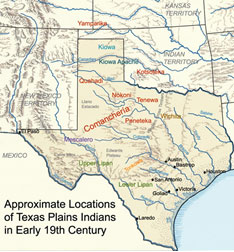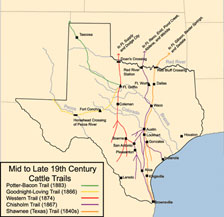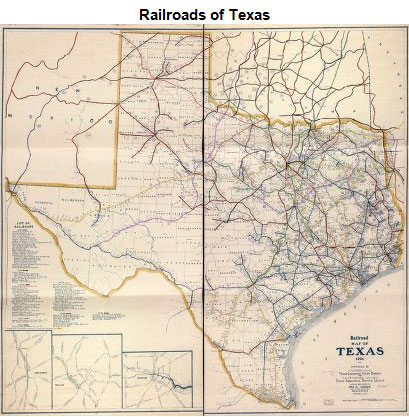
Source: College of Liberal Arts, University of Texas
The 19th century brought many changes for Natural Texas. During this century, Texas experienced a period of war, revolution, and political change. There were changes in the ruling bodies of Texas that eventually led to the statehood and annexation of the state. Socially, Texas experienced increased population growth as the result of foreign immigration, as well as natural population growth. Texas also experienced rapid economic growth during the 19th century.

Source: College of Liberal Arts, University of Texas
At the beginning of the 19th century, there were many Native Texas Indians who inhabited Texas. As shown on the map, early in the 19th century Native Texas Indians were located in many regions of Texas. This, however, began to change in the late 1800s. Harsh policies against Native Texas Indians and conflict with white settlers limited the movement of many Native Texas Indians forcing many onto reserved lands. Native Texas Indians had been the largest population group in Texas prior to the 19th century. By the end of the century their population had decreased drastically.
Next, Spain ruled over Texas from 1519 to 1821. During this time, Texas had been open to immigration by American and European settlers. By the 19th century, the flow of immigration had increased, and people from many European countries settled in Texas.
From 1821 to 1836, Texas was ruled by Mexico. It was during this time that white settlers such as Moses Austin and Stephen F. Austin obtained the initial land grant and invited 300 families to live in Austin Colony. The initial land grant eventually led to the immigration of 30,000 American families to Texas by 1836.
![]() Click on the map and answer the following question.
Click on the map and answer the following question.
How many land grants the Austin family owned, in part?

Not only was the population of Texas increasing, but the economic development in Texas was also growing. The agriculture industry prospered the economy. The fertile land throughout the region made for a productive farming industry, with cotton and corn as the two main crops. This boom in the economy had a profound effect on the geography of Texas.

Source: Map Mid-to-Late- 19th Century Cattle Trails in Texas Map, Texas Historical Commission
Cattle ranching also became an important industry in Texas by the late 19th century. The Texas landscape was carved with trails that led from South and East Texas to the railroads in the Midwest where cattle could be sold.
As more farmers and ranchers turned to commercial farming and ranching, the cattle trails were replaced with railroads. Ranchers and farmers now needed ways to get their products to places outside of Texas making the railroad system a necessary mode of transportation.

Source: Railroad Map of Texas, American Memory, Library of Congress
The railroad industry, which had grown out of the commercial farming and ranching industries of the 19th century, provided a means for shipping goods and supplies and connecting buyers and sellers. The railroads allowed goods to be shipped at cheaper rates. This, in turn, led to the prices of farming and ranching goods to drop.
Think about this: In what other ways did the railroad industry impact Texas?